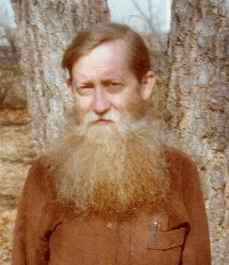
 |
The following is the author's account of the Brown Raid, excerpted from his book "Three Hundred Years". |
The next night, two dozen men-- six more than would make the famed raid on Harpers Ferry not a year later-- in two columns, packing "a miniature arsenal," set out from Fort Snyder, over into slumbering, unsuspecting, wintry Missouri. The main file of fifteen men was lead by John Brown himself. Southeast they rode, along the chain of low, timbered "mounds' or ridges here paralleling the Border, toward the "plantation" of Jim's prosperous master-- his late master, rather, for James Lawrence had died in his bed back on February 28, his property was in probate and in the custody of his son-in-law, Harvey G. Hinklin, Henry Township constable, who was living in the house with his wife and children.
When the raiders thundered into the yard and demanded entry, Hicklin just had just time to spring from bed and hide his money before the door burst in. While the intruders were turning the place upside down, helping themselves to saddles, boots, shotguns, and similar tidbits, Brown affably assured Hicklin they were merely "doing the Lord's will." This consisting of stripping the place of its livestock, wagons, provisions, and equipment-- plus its five slaves: a young man named Sam; the broom-peddling Jim; Jim's wife Narcissa; and their two small children.
Moving on to the nearby LaRue farm, the raiders grabbed five more slaves-- "also six head of good horses, one wagon, 800 pounds of pork, a lot of bedding, clothing, and many other articles." When they retreated they took along two white men as temporary hostages.
The second column, meanwhile, swooped down on the house of David Cruise, farther south across the Little Osage River. Some accounts put this detachment under the command of Aaron D. Stevens; others give the dubious honor to John Henry Kagi, a longtime radical activist, "a melancholy brigand" who had ridden on many forays with Montgomery, including a recent one on Fort Scott in which he killed J. H. Little, then himself penned the New York Tribune account of the incident!
The inclusion of Cruise's place in the foray doubtless is explainable from Cruise's reputation for "buried gold." A modestly prosperous farmer, though owning only two slaves, Cruise was an old man, but also a man of spirit. Several versions of the night's events have come down. As neighbors told it, when the raiders banged on the door, cursing and threatening, Cruise leaped out of bed and grabbed his revolver; but the cylinder became entangled in a ribbon and so would not revolve or fire. As he threw down the useless weapon, the door gave way and a shot range out; the old man "fell near the fireplace and died almost instantly, his blood flowing out upon the hearth-stone."
According to Cruise's young son Rufus, however, in an 1887 letter, the raiders gained entry by subterfuge, pretending to be travelers seeking a night's shelter. Cruise took pity on them, called off the dogs, and opened the door. Once inside, the men gathered around the fire, and suddenly on of them-- Al Hazlitt, said Rufus-- drew his pistol. "I broke out of the house on the porch," he went on, "and I heard the pistol shot that killed father. I am sure it was Al Hazlitt shot him." Barefooted and in his nightclothes, Rufus fled three miles over snow-covered ground to the house of Mr. Mitchell, a relative.
The "liberators," in their heroic efforts in aid of the cause of freedom, now began a systematic pillage of the premises. One held a gun to Mrs. Cruises's head and forced her to open all the closets. Then the band left, taking Cruise's horses, a wagon laden with provisions, two yoke of oxen, jewelry, and one female slave (Jane). When they rejoined Brown and the others Hazlitt was riding a fine new horse.
When the raiders first came in, according to Rufus Cruise, their slave woman, Jane, saw them through the window, knew their real purpose, and laughed. "She went back to the kitchen and began to pack up. She took with her $60 in money, part hers and part my mother's."
"Perhaps she was unwilling (to escape the raiders), " asserts the county history; "but at any rate she was unable. A few days later she gave birth to a child." The other Cruise slave, "a likely man named George," was away from home "sparking" a slave woman at the nearby Martin home, according to Rufus; the county historian says he was home, "fled in terror," and hid from his would-be liberators. In any case, he faithfully stayed on afterwards with his murdered master's family.
Rufus added, "Father's pants were on a chair by the bed, and the robbers took $30 in gold out of the pockets." They missed the "buried gold," however-- if such there ever really was.
The identity of Cruise's killer has been the subject of considerable disagreement. Neighbors tended to blame Bill Beckford, a "desperate character," who guided the raider to the house, and "hated Cruise personally." Yet following the abortive raid on Harpers Ferry some ten months later, the mortally wounded Aaron Stevens confessed that he had fired the shot that killed David Cruise, that wintry night back in far-away Vernon County. When he had first met John Brown in 1856, "Whipple ( as he called himself) was already known as a Free-State raider; it was less well known that he had deserted from the United States army after murdering an officer." Stevens' guilt was confirmed by Jane, Cruise's former slave.